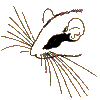

Dormouse Talk Instructions and Archives
How to Subscribe
Compliled and Edited by Werner
Haberl
Number of recipients: > 120
Please share your thoughts and answers with the rest of the group!
Replies to the following messages should be sent as CC-Mail to dormouse@glirarium.org
Dear Darren,
I am glad that at least one dormouser is alive and not in hibernation. Your situation, when you "have not found a single dormouse from 200 boxes", is very strange. I do not know any published source affirming that Muscardinus live in the area and never use nestboxes put up there. In which way (natural nests, gnawed nuts etc.) do you found that Muscardinus live in the area where your nestboxes are put up?
My question about Muscardinus population density in Britain and Lithuania was provocative. Indeed, I do not believe that Muscardinus population density can be so high (8-10 adults/ha), at least in larger areas. I do not think that feedings conditions for Muscardinus are much more better in Britain than in Lithuania, and Muscardinus population social structure is completely different in these two countries. I think that in many cases (not only in Britain) Muscardinus population density was overestimated. In all such cases population density was estimated in small areas (1-4 ha), and nobody paid attention to the "edge effect". The only exception in this respect I know was study by Lena Berg in Sweden, where "edge effect" was taken into account.
In Lithuania, the average population density of about 1 adult/ha was estimated in large forest areas (60 ha and 85 ha) covering approximately 22% and 17% of the areas occupied by the Muscardinus populations, respectively. I separate smaller areas inside these study sites dormice density can be higher and also less because of different environmental conditions.
The below presented quotation from "The Dormouse Monitor" (October 1999, p. 8) shows analogous situation in Britain: "At another birdie site, Garston Wood which is owned by RSPB, David Tucker concludes that "Dormice are distributed throughout the wood but densities appear to vary considerably; populations are clearly low in less favourable areas".
The other possible reason of overestimated population density in Britain - adults were defined as those animals weighing more than 16 g and juveniles those weighing less than 16 g. In this way many juveniles weighing more than 16 g were treated as adults. In Lithuania, it is impossible to distinguish adults and early born juveniles according their weight already in August, and in October some juveniles can reach the weight over 30 g (this year maximum was 35 g).
With best wishes from Lithuania,
Rimvydas Juškaitis
Dr. Rimvydas Juškaitis
Institute of Ecology, Akademijos 2, LT-2600 Vilnius, Lithuania
Dear Werner,
On 17-18 October I finished my field season with 35 Muscardinus found. This control gave interesting data on weight gain of dormice in October (between 6-7 and 17-18 of October). The results are very different in separate age groups:
The weather conditions are still favourable for dormice, but feeding conditions are becoming worse. It seems that only berries of buckthorn are the most available food source for dormice.
Best regards,
Rimvydas
Hi dormouse keepers and fans,
In our colony of African dormice (Graphiurus parvus) one animal partly changed the colour of its body fur into white: both flanks and the belly turned into pure white, while the rest of the body remained greyish-brown, resulting in a striking piebald pattern. This was the only case among about 150 animals bred in this colony over the years. Does anybody know about similar observations in other species of dormice? Any comment would be welcome.
Rainer Hutterer
Dr. Rainer Hutterer
Zoologisches Forschungsinstitut
und Museum Alexander Koenig
Section of Mammals
Adenauerallee 160
D-53113 Bonn
Number of Visitors (Date: 5 September 2000): >1380
Number of recipients: >120
Dormouse Talk Instructions: ... how to join, post & leave
Dr. Werner Haberl
Editor of DORMOUSE TALK & SHREW TALK
Chair, Insectivore Specialist Group
Species Survival Commission
IUCN - The World Conservation Union
Hamburgerstr. 11, A-1050 Vienna, Austria
Email: dormouse@glirarium.org
The Dormouse Hollow: www.glirarium.org/dormouse
The Shrew Shrine: members.vienna.at/shrew
IUCN / ITSES: members.vienna.at/shrew/itses.html
Back to Dormouse Talk Archives / Index